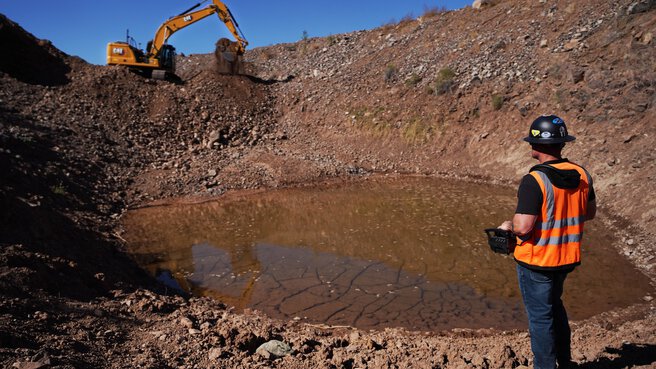Robotics, remote control and more
Increased efficiency, increased safety, reduced need for skilled labor—there are many factors that drive the development of autonomous construction equipment.
According to market research and consulting company International Data Corporation, construction is among the industries where expenditure for robotics will grow fastest in the coming years. The analysts expect an average annual growth rate of over 25 percent up to 2023. Reflecting the importance of this market trend, autonomous construction machinery was also one of the highlights of bauma 2022. Some recent examples:
Perfect drywall construction thanks to artificial intelligence
Among the drivers of the move toward autonomous machines is the shortage of skilled labor—for example, for accurate drywall construction. The U.S. start-up Canvas has developed a four-wheeled robot that uses sensors and artificial intelligence to scan unfinished walls before smoothing the surface and applying a near-perfect drywall finish. Although the machine still requires human supervision, Canvas says apprentices and journeymen can take on that task.
Semi-automated construction machines for dangerous terrain
Another argument in favor of construction machines that work as independently as possible is safety, which the U.S. manufacturer Caterpillar currently focuses on with its Cat Command solution. So far, this system has mainly been used to remotely control machines in the mining and quarrying industry. Starting this year, hydraulic excavators and dozers will be added. Areas of operation where it makes sense for the machine operator to operate from a safe location rather than in the operator's cabin can include landfills and gravel pits with unsafe soil conditions or other sources of danger. “Having more than ten years of experience in the use of fully autonomous mining trucks, we are now targeting autonomous work in the construction industry. With Cat Command, we are now on the road to semi-autonomous construction equipment,” emphasizes Jason Ramshaw, Global Commercial Manager of Caterpillar’s Construction digital & technology Division.
Autonomous load carrier for quarries
To drive the development and commercialization of autonomous transport solutions across the company, at the beginning of 2020 Volvo Group established the Volvo Autonomous Solutions business unit. “Our approach is to start in a narrowly defined environment and build on the successes achieved there over time,” says Perjohan Rosdahl. The Head of Off-Road at Volvo Autonomous Solutions continues: “A perfect place for this is quarries, which have clearly defined loading and unloading locations over generally short distances.” The company's autonomous and electrically powered load carrier TA15 is precisely aimed at this area of application. The machine's automation system uses GPS, lidar, radar and multiple sensors. Since the innovative vehicle does not require a driver, it comes without cabin, enabling a completely new machine profile. And this also convinced the jury of the international Red Dot Design Awards, which awarded the TA15 in the Product Design category last year. According to Rosdahl, a next step could be the use of autonomous Volvo construction machines in underground mining and tunnels. “With technology becoming more integrated over time, we could focus on large earthmoving projects, which are still limited in space but have more variables to manage,” says the business unit manager, looking to the future.
Fundamental work for the construction site of the future
“An important prerequisite for initially enabling partial autonomy even on more complex construction sites is cross-manufacturer machine-to-machine communication,” Joachim Schmid, Managing Director of the Mechanical Engineering Industry Association (VDMA) is convinced. Together with the Central Association of the German Construction Industry (HDB) the VDMA wants to create new opportunities in this area, so they founded the “Machines in Construction 4.0” (MiC4.0) working group at the bauma edition in 2019. One goal of MiC4.0 is to standardize data so that intelligent machines from different manufacturers can communicate with each other on the construction site of the future. The status of the work was presented at bauma 2022.
Media gallery






